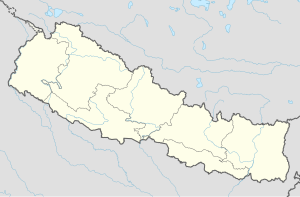world.wikisort.org - Nepal
Kodari is a small village located at the border with Tibet-China. [1] Kodari is at the end of Arniko Highway which connects Kodari with Kathmandu which is 144 KM away from Kodari. It is a border crossing from Nepal into the Tibet Autonomous Region.
Kodari
कोदारी | |
|---|---|
Border village | |
 View of Kodari from the Chinese side of the border. | |
 Kodari Location in Nepal | |
| Coordinates: 27.9735°N 85.9628°E | |
| Country | |
| Province | Bagmati |
| District | Sindhupalchok |
| Rural Municipality | Bhotekoshi |
| Elevation | 2,300 m (7,500 ft) |
| Time zone | UTC+5:45 (Nepal Time) |
Kodari is a part of Tatopani, which was a Village development committee (from 1990-2017). Kodari is now part of Bhotekoshi rural municipality in Sindhupalchok District of Bagmati Province. The other side is the town Zhangmu, Dram or Khasa, situated in Nyalam County, Shigatse Prefecture of the Tibet.
History
In ancient times, it was the starting point of a trans-Himalayan caravan route. Newar traders headed north from Kodari and after crossing Kuti pass turned east to continue their journey across the Tibetan Plateau to Lhasa. The construction of the 115 kilometres (71 mi) Kathmandu-Kodari Road during the 1963-67 period. It was named Araniko Highway in Nepal and China National Highway 318 beyond. As of 2011, Nepal is planning to expand it to six metalled lanes.[2]
China started building a railway in 2008 connecting Lhasa with Zhangmu on the Nepal-China border. It is an extension of the 1,956 kilometres (1,215 mi) Qinghai-Tibet Railway.[2][3][4]
In 2012, China signed agreement with Nepal to make this one of six ports of entries between Nepal and China.[5]
The April and May 2015 earthquakes essentially closed the route due to numerous landslides and boulders coming down, damaging roads in Nepal and Tibet (China).[6] There was an evacuation and people have been slow to come back, and there is large reduction in trading.[6] Chinese and Nepali officials met in December 2016 to discuss potential reopening of the port in 2017, which was blocked by progress of road construction.[7] The checkpoint finally reopened on 29 May 2019.[8] Due to the COVID-19 pandemic, the border closed until second week of June 2020,[9] then closed again until further notice (likely thru 2021) due to a landslide since July 9, while also warning of lakeburst of Tso Lake.
Geography
Kodari is located at an altitude of 2,515 metres (8,251 ft).[10] Kodari is 144 kilometres (89 mi) from Kathmandu. The height gain is from 1,317 metres (4,321 ft) to 2,300 metres (7,500 ft). On a clear day, the Himalayan chain is visible on both sides of the road. From Zhangmu to Nyalam, a distance of 33 kilometres (21 mi) the height gain is from 2,300 metres (7,500 ft) to 3,750 metres (12,300 ft).[11]
Transport
Kodari is just south of and above the Friendship Bridge border crossing where Araniko Highway becomes China National Highway 318 and immediately passes Zhangmu village in Nyalam County Shigatse Prefecture, Tibet Autonomous Region en route to Shigatse. Before the earthquake, tourists traveling between Nepal and the Tibet make substantial use of this crossing, and there was also substantial trans-border trade.
Chinese trucks traveling on the Tibet-Nepal Friendship Highway offload goods at Zhangmu and transfer them to Nepalese trucks. Even though the drive between Kodari and Kathmandu is only half an hour, the sourcing logistics and bureaucracy of cross-border trade takes around 2 weeks, as such in 2013 it takes each Nepalese truck almost half a month for a round trip.[12]
Gallery
- The Araniko Highway in Kodari just before the Sino-Nepal Friendship Bridge.
- The Sino-Nepal Friendship Bridge with Nepal on the left, and China on the right side of the Sun Kosi River.
- Women hard at work at the Sino-Nepal Friendship Bridge border crossing.
- Kodari customs buildings with view of Zhangmu on mountain slope in the background.
External links
References
- "Kodari". Retrieved 8 May 2019.
- "Kodari Road – Implications for Nepal, China and Inda". Institute of Peace & Conflict Studies. Retrieved 2012-01-02.
- "Nepal to get China rail link". Asia Times, 15 May 2008. Archived from the original on 2008-07-04. Retrieved 2012-01-02.
{{cite web}}: CS1 maint: unfit URL (link) - "New Railroads in Tibet open up economic opportunities". Yo! Learn Chinese! 6 September 2009. Archived from the original on 4 March 2016. Retrieved 2012-04-13.
- "中华人民共和国政府和尼泊尔政府关于边境口岸及其管理制度的协定" [China-Nepal Agreement on Port of Entry]. Chinese Embassy in Nepal. 2012-01-14. Retrieved 2017-02-10.
- Xu, Xiaotong; Liang, Siran (2015-12-18). "Bordering on helplessness". Atavist. Retrieved 2017-02-07.
- Jiao, Helen (December 30, 2016). "Zhangmu Port May Reopen in 2017-Tibet Travel News, Tibet Travel Blog". Tibet Travel Agency. Retrieved 2018-01-28.
On December 12, 2016, the representatives of China and Nepal held a meeting on reopening Zhangmu Port. The Nepalese official said that the 15km road from Sino-Nepal Friendship Bridge to Zhangmu Town was under quick development. He hoped that after the completion, the port could reopen.
- "Kodari Checkpoint To Open Today". The Spotlight Online. 2019-05-29. Retrieved 2019-06-28.
- "Nepal Republic Party condemns closure of border points by China". Khabarhub. 2020-09-25. Retrieved 2021-05-14.
- "Kodari, Nepal Page". Fallingrain Genomics. Retrieved 2012-01-02.
- Gibbons, Peter; Pritchard-Jones, Sian (9 September 2010). The Mount Kailash trek: a trekker's and visitor's guide. ISBN 9781852845148. Retrieved 2012-01-02.
- "318国道终点站--樟木" [Terminus of G318 Highway — Zhangmu]. Yuanfang De Jia. Season 北纬30°·中国行. Episode 184. 2013-03-19. China Central Television. Retrieved 2017-02-14.
Другой контент может иметь иную лицензию. Перед использованием материалов сайта WikiSort.org внимательно изучите правила лицензирования конкретных элементов наполнения сайта.
WikiSort.org - проект по пересортировке и дополнению контента Википедии




